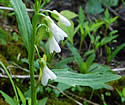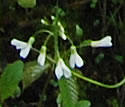Cardamine bulbosa (Spring Cress)
| Also known as: | Bulbous Bittercress |
|---|---|
| Genus: | Cardamine |
| Family: | Brassicaceae (Mustard) |
| Life cycle: | perennial |
| Origin: | native |
| Habitat: | part shade, sun; moist to wet; low woods, seeps, wet meadows, streambanks |
| Bloom season: | April - June |
| Plant height: | 8 to 24 inches |
| Wetland Indicator Status: | GP: OBL MW: OBL NCNE: OBL |
| MN county distribution (click map to enlarge): |  |
| National distribution (click map to enlarge): |  |
Pick an image for a larger view. See the glossary for icon descriptions.
Detailed Information
Flower: 

![[photo of flowers]](/udata/r9ndp23q/pd/cardamine-bulbosa-7983-3-t.jpg) Elongating cluster of white flowers on slender stalks at the top of the plant and arising from leaf axils in the upper plant. Flowers are about ½ inch across, have 4 white petals with rounded tips each 2.5 to 4.5 mm long, and 6 creamy white to pale yellow stamens in the center. The 4 sepals behind the flower are much shorter than the petals, pale greenish white around the edges. Flower stalks and sepals are all hairless.
Elongating cluster of white flowers on slender stalks at the top of the plant and arising from leaf axils in the upper plant. Flowers are about ½ inch across, have 4 white petals with rounded tips each 2.5 to 4.5 mm long, and 6 creamy white to pale yellow stamens in the center. The 4 sepals behind the flower are much shorter than the petals, pale greenish white around the edges. Flower stalks and sepals are all hairless.
Leaves and stems: 


![[photo of basal and lower leaves]](/udata/r9ndp23q/white/cardamine-bulbosa-spring-cress_0429_112148-t.jpg) There are both basal and alternate stem leaves. Basal and lower stem leaves are ¾ to 2 inches (2 to 4+ cm) long, oval, round to kidney shaped, hairless, on a stalk usually longer than the leaf blade. The edges may be toothed, scalloped, or toothless, and are often wavy.
There are both basal and alternate stem leaves. Basal and lower stem leaves are ¾ to 2 inches (2 to 4+ cm) long, oval, round to kidney shaped, hairless, on a stalk usually longer than the leaf blade. The edges may be toothed, scalloped, or toothless, and are often wavy.
![[photo of upper stem leaves]](/udata/r9ndp23q/pd/cardamine-bulbosa-87398-t.jpg) The 2 to 4 stem leaves are typically widely spaced and become less round, proportionately longer and narrower as they ascend the stem, the uppermost leaves stalkless and more generally oblong, longer than the basal leaves and the edges toothless or with a few irregular teeth. Stems are hairless or sparsely hairy and mostly unbranched except near the flowers.
The 2 to 4 stem leaves are typically widely spaced and become less round, proportionately longer and narrower as they ascend the stem, the uppermost leaves stalkless and more generally oblong, longer than the basal leaves and the edges toothless or with a few irregular teeth. Stems are hairless or sparsely hairy and mostly unbranched except near the flowers.
Fruit: 
![[photo of fruit]](/udata/r9ndp23q/white/spring-cress_0516_152926-t.jpg) Fruit is a straight, linear, flattened pod about 1 inch (2 to 3.5 cm) long, the stalks ascending to spreading and the pods mostly ascending.
Fruit is a straight, linear, flattened pod about 1 inch (2 to 3.5 cm) long, the stalks ascending to spreading and the pods mostly ascending.
Notes:
Spring Cress, formerly Cardamine rhomboidea, is fairly easy to identify from its roundish, unlobed basal leaves and narrowing stem leaves. The flowers are most similar to Cut-leaf Toothwort (Cardamine concatenata), which has deeply lobed leaves, is a shorter plant, and primarily a woodland species. While Spring Cress is not an uncommon species, unless you like traipsing around mucky seeps and wetlands, it is not so likely to be encountered.
Native Plant Nurseries, Restoration and Landscaping Services ↓
More photos
Photos by K. Chayka taken at Battle Creek Regional Park, Ramsey County. Photos by Peter M. Dziuk taken at Pine Bend SNA, Dakota County, and in Ramsey and Goodhue counties.
Comments
Have you seen this plant in Minnesota, or have any other comments about it?
on: 2017-06-01 16:43:48
Found near a spring on a western slope south and east of Rochester







 Spring Cress plant
Spring Cress plant Spring Cress plants
Spring Cress plants Spring Cress habitat, with Skunk Cabbage and Angelica
Spring Cress habitat, with Skunk Cabbage and Angelica